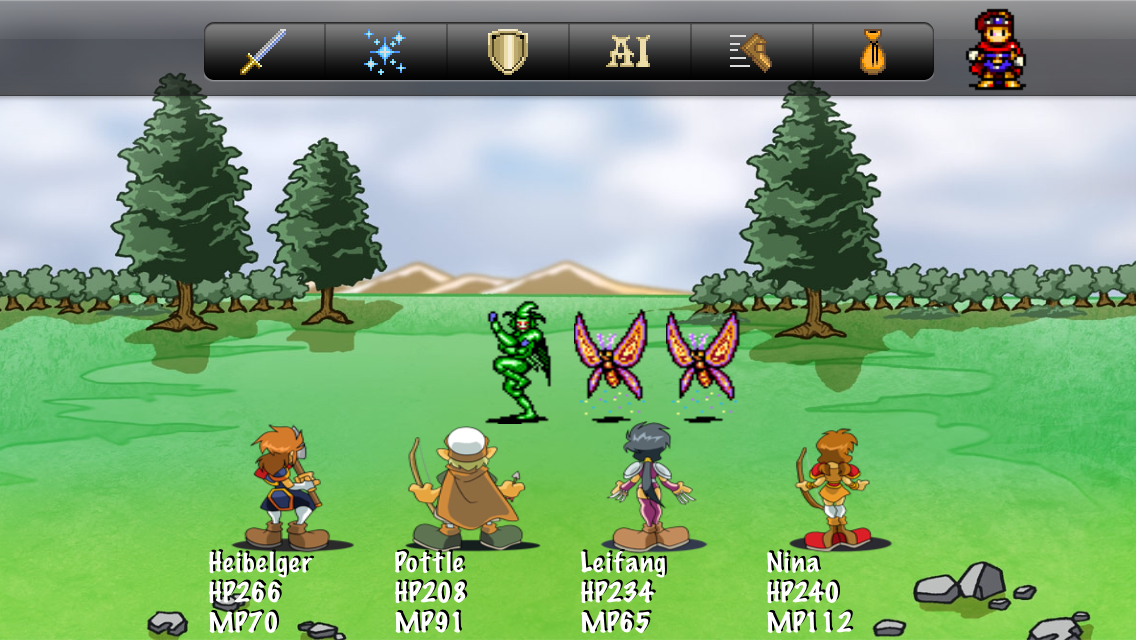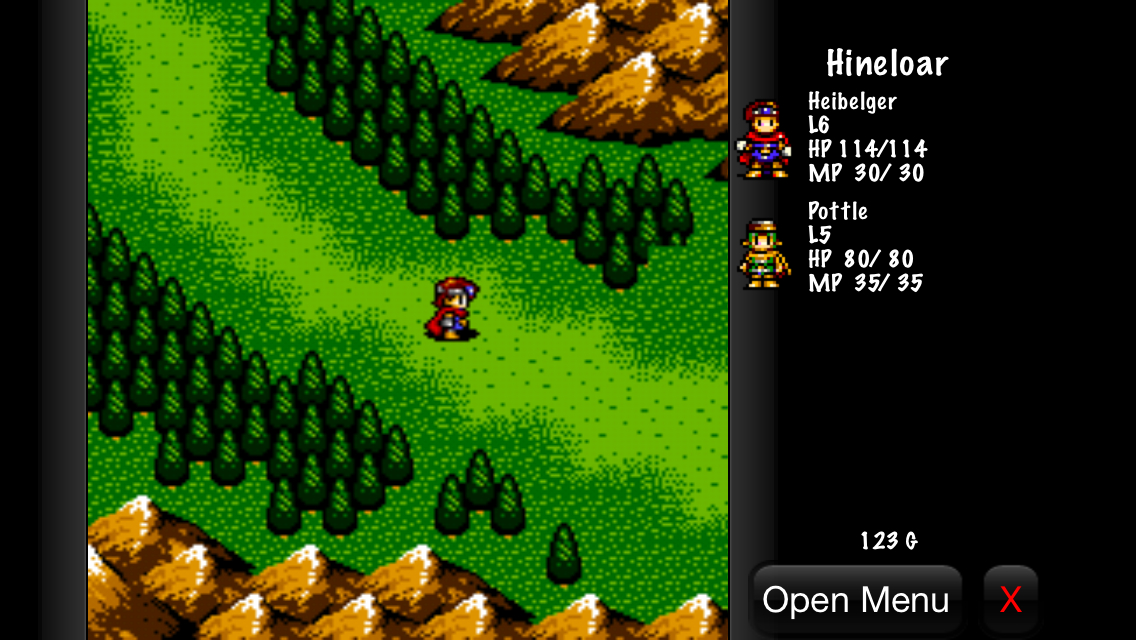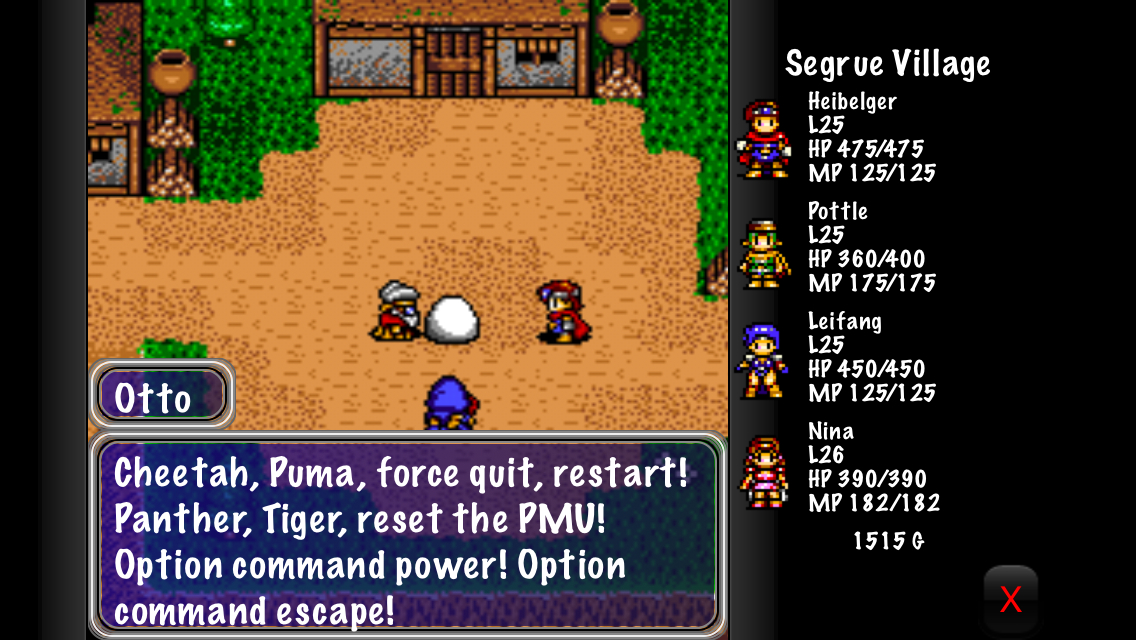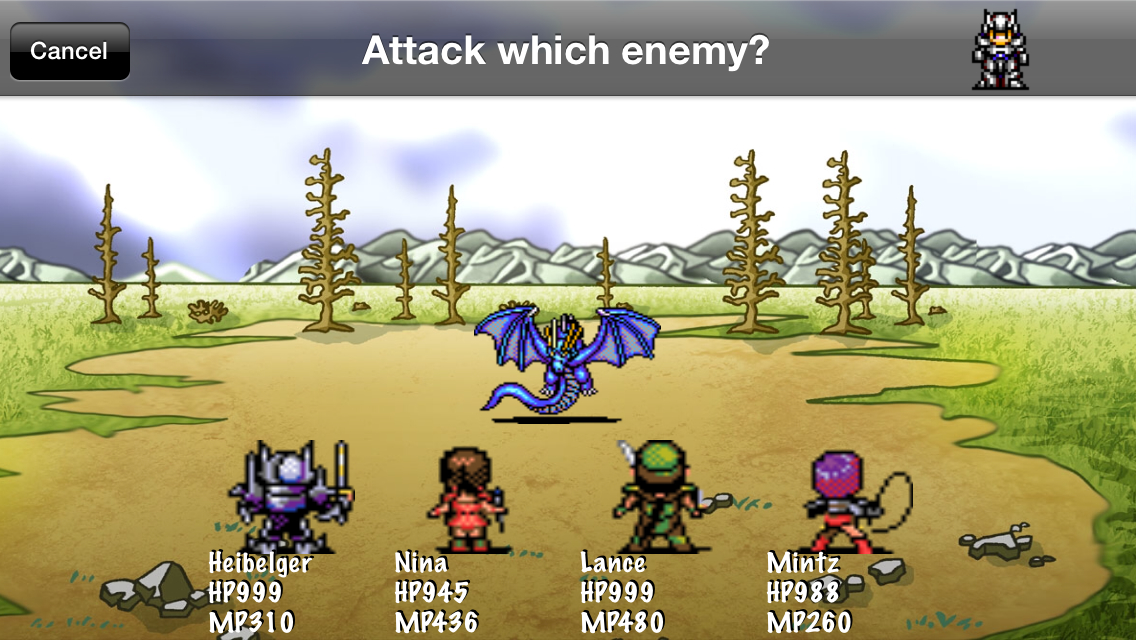 Hello, gentle readers, and welcome to the RPG Reload, the weekly feature where we never run out of amnesiac magical princesses. Each week, we take a look at an RPG from the App Store’s past to see how it’s doing in the amazing land of tomorrow. It’s a bit of revisiting, a bit of reflecting, and the chance to take a deeper dive than you would usually see in our reviews. Any and all RPGs are welcome here, and I try to put together a reasonably balanced plate from week to week. In order to assist me with that, I need you to vote for a game you would like to see me play and write about. Simply drop your suggestion in the comments below, post in the Official RPG Reload Club thread in the forums, or tweet me at @RPGReload. This is your last chance to put in your choice for the March reader’s choice article, as it’s coming up in just two weeks. Make it count!
Hello, gentle readers, and welcome to the RPG Reload, the weekly feature where we never run out of amnesiac magical princesses. Each week, we take a look at an RPG from the App Store’s past to see how it’s doing in the amazing land of tomorrow. It’s a bit of revisiting, a bit of reflecting, and the chance to take a deeper dive than you would usually see in our reviews. Any and all RPGs are welcome here, and I try to put together a reasonably balanced plate from week to week. In order to assist me with that, I need you to vote for a game you would like to see me play and write about. Simply drop your suggestion in the comments below, post in the Official RPG Reload Club thread in the forums, or tweet me at @RPGReload. This is your last chance to put in your choice for the March reader’s choice article, as it’s coming up in just two weeks. Make it count!
I’ve been writing the RPG Reload feature for a while now. We’ve revisited a lot of great games, a few flawed but still interesting ones, and some pretty big names over that time. This week’s article is a bit different because the game in question isn’t really all that good, nor is it particularly special or well-known. It is a game that has benefited greatly from the contexts it has released in more than from anything in the adventure itself. Still, it’s a part of history, even if it mostly comes down to stupid luck, so it’s certainly worth taking a look at. This week, we’re looking at the port of the not-so-classic SEGA CD adventure, Vay ($5.99). Let’s just buckle up and hope we learn something here. I, for one, have already learned that I’ve been pronouncing the name of the game incorrectly for years. It rhymes with ‘die‘, not ‘day‘. The things you find out when you check the katakana of games largely forgotten, I suppose.

Let’s set the stage, first of all. It’s 1993. Zack Morris and the gang had just graduated from Bayside High School. Neon Genesis Evangelion wouldn’t come along to destroy/rebuild Japanese animation for two years yet. In North America, fighting games were winning the market as politicians starting losing their minds over Mortal Kombat. In Japan, RPGs were still white-hot to the point that every developer, whether capable or not, simply had to have one in their catalog. Amidst all of this, the ill-fated SEGA CD add-on for SEGA’s Genesis/Mega Drive was struggling badly, just a year away from being made redundant by the coming perfect storm of Sony’s surprising competence and SEGA’s famously poor management. The first Lunar ($9.99) game, released the year before, had thrilled RPG fans, but like the overall library, the genre had seen very little action since then. The following year would bring a few more noteworthy RPGs, but 1993 looked like it was going to squander the goodwill Lunar had built up.
Whether it was requested by SEGA or simply delivered in deference to market trends, a company by the name of SIMS stepped up. SIMS was a joint venture between SEGA and a large Japanese consumer electronics company by the name of Sanritsu. They generally did the thankless job of trying to port SEGA’s arcade titles to hardware that was woefully under-equipped to handle them. If you ever played the port of Outrun on the SEGA Genesis, you’ve played a SIMS-developed game. They also were frequently given the task of making Game Gear spin-offs, licensed games such as Mighty Morphin Power Rangers, and even occasionally got to make original titles, almost all of which were fishing games. In 2004, they separated themselves from SEGA to make a go of things on their own. They mostly make fishing and hunting games, the sort of titles comfortably at home in a Wii budget bin. And then there’s Vay.
SIMS tapped one of their frequent collaborators to develop Vay, likely spotting a convenient hole in the SEGA CD’s release calendar. The developer’s name was Hertz, and Vay would be their final title. Looking at their full historical list of releases, they actually seem to have gone out on a high note by their standards. At any rate, Vay was their first RPG, and while I’ve seen worse efforts from the era, they certainly don’t appear to have had much passion for what they were doing. It checks off a number of boxes, to be sure. Behind the back battle screens similar to SEGA’s own Phantasy Star. A blend of fantasy with touches of sci-fi, like Final Fantasy. Animated and fully-voiced cut-scenes as in Lunar. Melodrama abounds, as in too many JRPGs to list. It goes through all the motions but never seems to really give a damn about doing things properly, more than content to just be a reasonably well-made generic RPG. Sort of the Kemco RPG of its era, I guess you could say.

Like those games, Vay took advantage of a somewhat-starved audience who were willing to take anything as long as it wasn’t terrible. SEGA CD owners were willing to put up with its bizarre up-and-down difficulty, heavy grinding, and bland combat simply to have something to play. I can’t find any data on how well Vay sold in Japan, but I imagine it did alright, because it managed to attract the attention of Working Designs, who picked it up for a US release the following year. Here again, Vay lucked out. This time, its fortune was in following mere months after the US launch of Lunar: The Silver Star. That game had surprised many with its quality, and fans were eagerly awaiting the next hot RPG from the company that had delivered it. To their credit, Working Designs managed to put some personality into an otherwise extremely dry script, lending a very high-quality localization to the game in a period where most others were still years away from coherence. They even filled out the voice cast with several once and future Lunar voice actors, including O-Town’s Ashley Angel, who had voiced protagonist Alex in that game. In Vay, he plays the first addition to your party, a young elf wizard named Pottle who plays a central role in the main scene people remember from this game.
Once again, Vay fed the starving. It seemed that after that it would be consigned to falling through the cracks of history, but fate would call it back one more time to serve a similar role for a new generation. Vay released on iOS courtesy of SoMoGa, who would go on to also release the first Lunar game on the platform. It launched only a handful of days after the iOS App Store itself did, on July 15th, 2008. Vay weighed in at a positively massive 50 MB, one of the largest iOS games to date at the time. For the owners of iPhones, iPod Touches, and the brand-new iPhone 3G, a game the size and complexity of Vay was a rare sight indeed, and its $4.99 price tag was extremely reasonable. It must have been fairly successful for SoMoGa to go on to release Lunar, so being in the right place at the right time had served the game well yet again. One can only wonder where it will turn up next. Perhaps the WiiU?

Vay tells the story of Prince Heibelger, whose wedding day is interrupted by a platoon of giant mechs who steal away his bride, Elin, and murder his parents. The mechs come from Danek, an evil empire that has discovered long-covered secrets of an ancient civilization and are using them to take over the world. So, plus five points for giant robots crashing the wedding of a prince who looks like David Bowie, but I’m going to subtract ten points for using a hackneyed “battle the evil empire to rescue the princess" plot. I get it, you like Star Wars, we all like Star Wars. Bad enough Final Fantasy couldn’t stop mugging from it, we don’t need some sort of also-ran doing its impression. I’d like to say that Vay fleshes things out to become more than its generic plot would have you predict, but I’m not in the business of lying to you, friends.
Heibelger sets out on a journey across a conveniently linear world, stopping in each town to get directions to the nearest monster hole where he can find his next plot coupon. He’s joined by a handful of companions, though in typical fashion for the time, no one can join once the party is full unless someone else leaves for some reason. The other characters get very little in the way of character development. They find some excuse to join your party and then don’t do a whole lot after. Granted, Heibelger himself doesn’t do much developing through the course of the game, either. You’ll hit the usual stops on the tour: a magma-filled cave, an underwater palace, a dusty desert, and so on. Apart from the incredibly creepy next-to-last dungeon, which adopts a horrifying biological motif, very little of it stands apart. It all culminates in a final battle where Heibelger, clad in the Legendary Vay Armor, battles a similarly suited foe for the stakes of the entire world. All the while, a song very suspiciously similar to “Techno Syndrome" by The Immortals plays in the background. You probably remember that song from its remixed form in the Mortal Kombat movie.
If you’re looking to play Vay, the iOS version is the clear choice to do so. Not just to get around the loading times that come from a 20-year old single-speed CD-ROM drive, either. As I mentioned, one of the things Vay was criticized for was its stupid difficulty roller coaster and excessive grinding. Experience points and gold earned seem to have little correlation with the difficulty of the enemies you’re fighting, leveling is slow, and everything costs a lot of money. At the same time, you can’t really make it without keeping your gear relatively up to date. Vay is a 12 hour game, but you’ll spend almost half of those hours fighting random battles to toughen yourself up for the next boss. It’s a very unpleasant experience, since the battles don’t offer much in the way of strategic choices or things to play around with.
The battles in the iOS version are still fairly brain-dead, but the default difficulty has been toned way down all-around. You’ll level up easier, earn more gold more quickly, and deal more damage to tough enemies than you ever could have in the SEGA CD version. For example, at one point in the game, you need to pay off a character’s bar tab for them to help you out. The game gives you a ton of gold leading up to this in preparation, but if you spend it before then, you’re going to have to earn it again yourself. The cost of the tab in the SEGA CD version is 20,000 gold, a very hefty sum for that part of the game. In the iOS version, it’s a mere 1,000 gold. If for some reason you want the original difficulty back again, you can switch the game to hard mode in the settings and enjoy it in all of its glory. The game is an absolute pushover on its default setting, but I greatly prefer that to its original state. It would be nice if the encounter rate was trimmed down along these lines, but it’s sadly as erratic and frequent as ever.
Since the original version was meant to be played in a 4:3 aspect ratio and the iOS version runs in landscape mode, there’s the matter of extra screen real estate to consider. Vay handles this differently depending on whether you’re in a battle or outside of one. The graphics in battles have been completely redrawn, stretching out to fill the entirety of 4-inch screens or smaller. The new art is pretty weak, to be frank. The enemy sprites are the same as the SEGA CD version, but the backgrounds have been replaced with simple-looking high-resolution approximations of the originals. The main characters suffer the worst, redrawn in a garish style that calls to mind the elephant-footed Kingdom Hearts cast. You can switch back to the original sprites in the settings, thankfully, but those sprites were never meant to be displayed on a screens like the ones in iOS hardware, and it shows. Still, you have to give props to a 2008 port of a 1993 16-bit game having support for iPhone 5 and Retina displays. Certain companies could take notes here.

Outside of battles, Vay takes a less drastic approach. The play area is windowed, with each character’s status displayed on the unused portion of the screen. I’m mostly okay with that, I suppose. It’s nice having the information handy, the added shortcuts to the menus are useful, and I generally prefer that less of the game was hit with the ugly stick that smacked the battles. The big problem here actually ties in with the unusual control layout of the game. Battles are easy enough, as you just have to choose what you want by touching your way through menus. While exploring, however, you need to move your character. Most RPGs adopt a virtual directional pad for this, a sloppy but kind of necessary concession. Vay uses a pretty strange set-up where you can double tap in a direction to have Heibelger sprint towards it or single tap near him to have him slowly move square by square. It later got a more manageable, but still pretty lousy, control method brought over to it from Lunar where you can simply slide your finger in the direction you want the character to go. The issue here is that you have to move your finger relative to where Heibelger is on the screen. With cramped quarters due to the windowing, it’s sometimes troublesome to get him going where you want him to. In dungeons, the encounter rate can make this quirk absolutely maddening at times.
Vay shows its age in other curious ways, as well. A great deal of the user interface makes use of default iOS menus whose pre-iOS 7 stylings are kind of jarring to see in a game in 2015. Then there’s the matter of the settings, which are not found in-game as you might expect. Instead, you’ll have to open your device’s Settings app and scroll down to find Vay. Some of them are expected, like audio settings or the ability to turn on or off the status bar display. Others are more uncommon, like being able to change the names of various characters or turn NPC movement on or off. This is also where you’ll find the switch to turn on hard mode and the toggle for the original character sprites. In the game itself, you can find a bonus menu that only unlocks after beating the game, and there’s a real treasure trove in there. You can even play buggy, unfinished versions of levels that were cut from the final game. Pretty neat!
While we’re on the topic of the names, let’s discuss the localization of the iOS version of Vay. If you’ve played the game before in its SEGA CD form, you’re probably wondering who the devil this Heibelger fellow is. While the game was originally localized by the famous Working Designs, this version has received a near-total rewrite. The names more closely match the Japanese version, and that’s about where all pretenses of being faithful to the original script went out the window. This is one of the wackiest localizations I’ve seen in a game in a long time. It’s filled to the brim with jokes about taxes, pop culture references so brazen that they would sit easily among WD’s worst, and bizarre references to Bush Jr.-era American politics. Even the messages when you open chests are strange, changing up almost every dungeon.

It’s clearly aiming for the same off-the-wall humor Working Designs was known for, an interesting choice in this case because Vay was actually one of their straighter localizations. I can’t decide if I like it for spicing up the dialogue in an otherwise dry story or if I dislike it because having NPCs whine about the tax rate in California really pulls me out of the setting. It’s… it’s something, alright. The voice actors have also been replaced, of course, with the finest people SoMoGa could find walking around outside the building at lunchtime. The voice acting is pretty terrible all around, but there’s not much of it, so it doesn’t really make or break the game at all. You’ll only hear it during the game’s handful of cut-scenes.
Should you play Vay? Well, I don’t know. It’s a pretty short game, and the iOS version goes down smoothly. Its price is also very low these days, and it’s certainly no worse of a game than at least half of Kemco’s output. It’s one of those games that is really just there to fill the belly as opposed to satisfying your taste buds, and it’s no surprise that any successes it has had have been in that context. If nothing else, it’s a rare glimpse into a very particular time and place in the console industry. We don’t see a lot of SEGA CD games ported around, mostly for good reason, but there’s still a certain character to them that can be interesting to experience. At the very least, you have to appreciate how much on-going care the developers have given to such an old and somewhat forgettable title. That might be worth your dollar alone.
That’s just my take on Vay, though. What do you guys think? Any memories, near or distant, of either version? I want to know, so leave a comment below, post in the Official RPG Reload Club thread, or tweet me at @RPGReload. As for me, I’ll be back next week with another classic RPG, and this time it’s a really good one. As always, thanks for reading!
Next Week’s Reload Hint: Crawling out of a spider-infested hole.